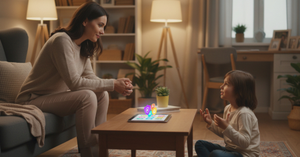Once reserved for emergencies or rural areas, telemedicine has quickly become a part of routine pediatric care. Whether it’s a toddler with a mild fever or a child needing follow-up for asthma, more parents are choosing virtual consultations for convenience, safety, and speed. And it’s not just a pandemic-era trend’s a real shift in how healthcare is delivered for children.
But how effective are video consults for little ones? What kind of problems can actually be handled virtually? And how can parents make the most of a digital doctor’s visit?
Here’s everything you need to know about telemedicine for kids: its advantages, limitations, and how to prepare for your child’s online check-up.
What Is Telemedicine, Exactly?
Telemedicine refers to the use of video, phone, or app-based platforms to consult with a healthcare provider from a distance. In pediatrics, it allows a child to be evaluated, monitored, or treated by a pediatrician or specialist without leaving home.
This can include:
- Video calls for mild illnesses or follow-ups
- Sending photos of rashes or injuries
- Using connected devices (like digital thermometers or pulse oximeters) for real-time data
- Chat or app-based medical advice in non-urgent situations
In India and globally, child-focused telemedicine platforms are gaining popularity, offering everything from speech therapy to mental health consultations online.
Why Parents Are Choosing Telemedicine for Their Kids
1. Convenience Without the Commute
No more rushing to a clinic or sitting in long waiting rooms. Parents can consult from home, even late at night or while traveling.
2. Less Exposure to Infections
Especially for infants or immunocompromised children, avoiding clinic germs is a major benefit.
3. Comfort and Familiarity
Children are often more relaxed in their own environment, making it easier for the doctor to assess behavior and communication.
4. Easy Access to Specialists
For families in smaller towns or tier-2 cities, telemedicine connects them to pediatricians, ENT specialists, or child psychologists without the need to travel.
5. Efficient Follow-Ups
Chronic conditions like asthma, allergies, ADHD, and constipation often require regular check-ins. Virtual consults make ongoing care much easier.
What Telemedicine Can Handle for Kids
Teleconsultations work well for:
- Fevers and colds (mild to moderate)
- Cough, sore throat, and runny nose
- Mild rashes or skin allergies (photos help)
- Constipation, gas, or feeding issues
- Follow-ups for asthma, diabetes, or allergies
- Parenting guidance on sleep, nutrition, toilet training
- Developmental concerns or behavioral questions
- Mild injuries or insect bites
With clear history-taking and a parent’s help, many of these concerns can be managed effectively at home, with a prescription or advice delivered digitally.
What Can’t Be Done Virtually?
Telemedicine is not suitable for:
- Emergency situations: Breathing difficulty, seizures, unconsciousness
- Severe infections or high fever in infants under 3 months
- Wounds needing stitches, broken bones, or burns
- Ear pain with fluid discharge (requires physical exam)
- Abdominal pain that’s sharp or persistent
- Any condition needing a physical exam, lab test, or scan immediately
In these cases, a virtual doctor may guide you briefly, but an in-person visit is essential. Telemedicine should never delay emergency care.
How to Prepare for a Pediatric Teleconsultation
To get the most out of your online visit, here are some tips:
1. Choose a quiet, well-lit room.
Natural light helps doctors observe rashes, eye color, and your child’s general alertness.
2. Keep basic health info ready:
- Child’s weight and temperature
- Symptoms: onset, duration, pattern
- Any medications already given
- Photo of rash, wound, or affected area if applicable
3. Involve your child, if appropriate.
For older kids, let them speak to the doctor briefly. This helps build trust and gives clues about their well-being.
4. Have your questions written down.
Don’t hesitate to ask about treatment, dosages, diet, or next steps.
5. Follow-up after the consultation.
Save any prescriptions or summaries, and complete follow-up visits as advised.
Are Online Prescriptions Valid for Kids?
Yes—if the platform and doctor are licensed. In India, the Telemedicine Practice Guidelines (2020) allow qualified doctors to issue prescriptions via digital platforms. Just ensure:
- You are consulting a verified pediatrician
- The platform follows privacy norms and stores health data securely
- You’re not relying on AI or bots for serious medical advice
Special Telehealth Services for Kids
Beyond general pediatrics, several child-focused virtual services are now available, including:
- Child psychologists and counselors (for anxiety, ADHD, or behavioral concerns)
- Speech and language therapists
- Pediatric nutritionists
- Online lactation support for new mothers
- Home-based physiotherapy or occupational therapy for developmental delays
These are particularly helpful in early intervention for children with learning disabilities, autism, or delayed milestones, where regular in-person sessions may be challenging to access.
What Indian Parents Are Saying
Many parents report that telemedicine:
- Saves time and travel, especially with multiple kids
- Reduces anxiety for first-time parents dealing with fevers or feeding concerns
- Offers comfort and flexibility, especially for nighttime issues or minor follow-ups
- Helps access quality pediatricians from anywhere—even smaller towns or remote areas
However, it’s essential to maintain balance. Telemedicine should support your pediatrician’s care, not replace it entirely.
Conclusion: A Screen Away, But Still Personal
Telemedicine has opened a new chapter in children’s healthcare, where help, advice, and reassurance are just a click away. For parents juggling busy schedules or caring for kids with chronic issues, it’s a powerful tool that offers convenience without compromising care.
That said, it’s not a substitute for in-person pediatric assessments when truly needed. The key is to use telemedicine wisely, knowing when a virtual visit is enough and when your child needs to be seen and examined physically.
In the right situations, telehealth for tots is not just safe it’s smart parenting.








Be the first one to comment on this story.